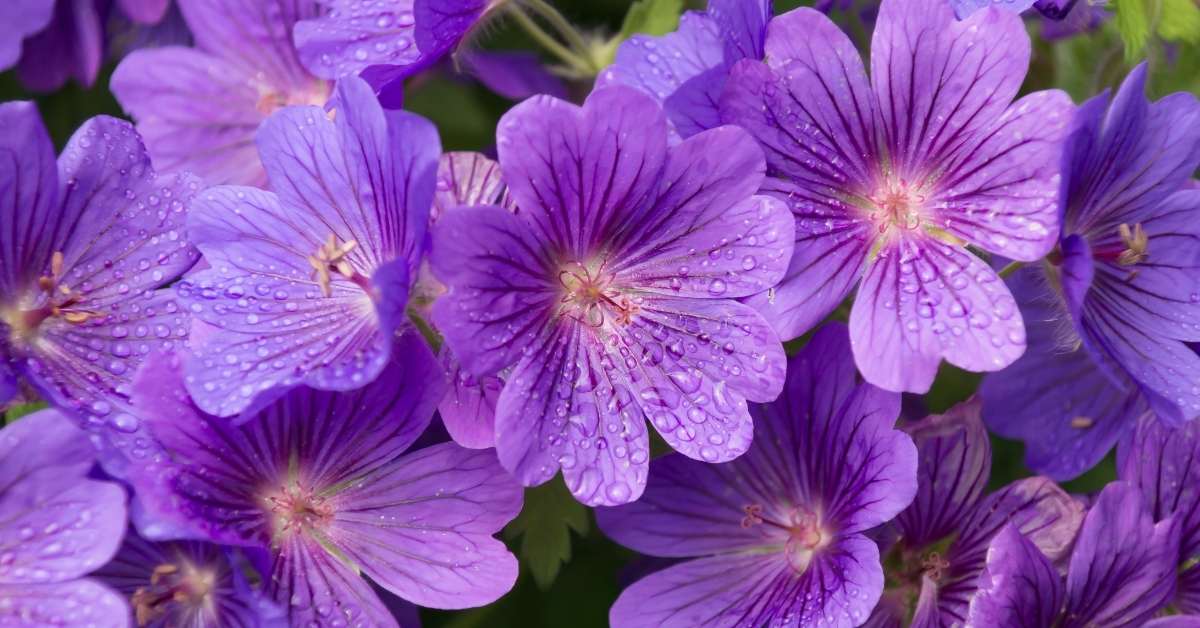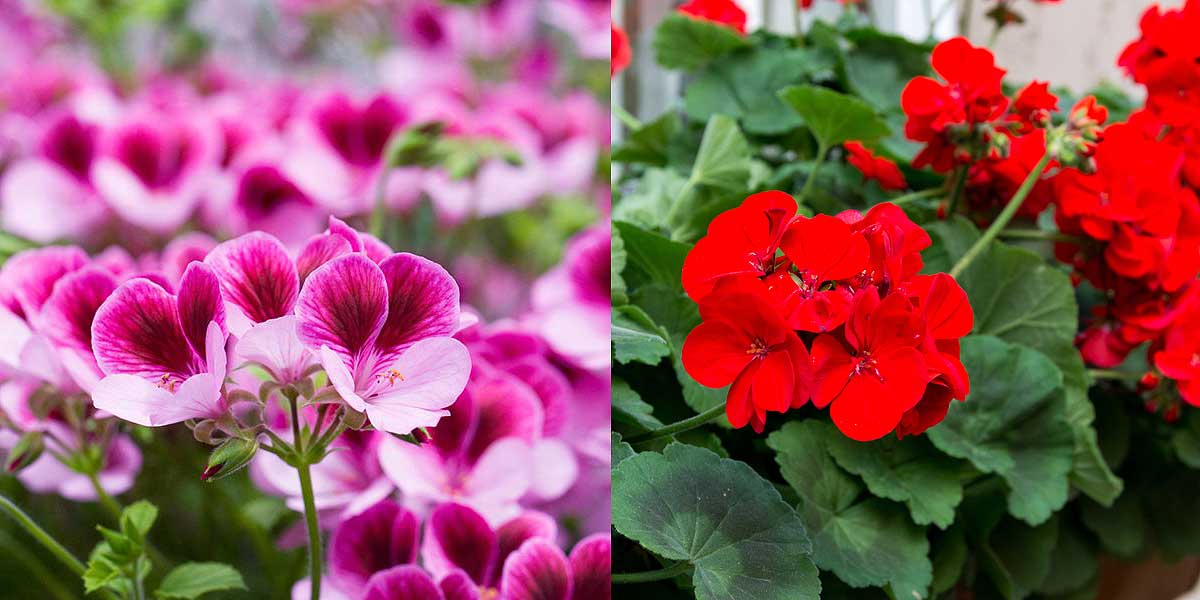I’m in love with perennial geraniums. And as with all love affairs, I just can’t get enough of my beloved. Yeah, I know – none of you are falling for that line, and you’re just waiting for me to get to the punch line and tell you about the wonderful new plants I’ve discovered now.
I’m talking about hardy geraniums here, not those tender cosseted pelargoniums that have usurped another’s name. I’m talking about the plant the Greeks named “Geranion” (first called by some chap named Dioscorides) that was taken from the word “geranos” or “crane” that referred to the long beak of the seed pod.
Growing Perennial Geraniums
Our hardy geraniums, referred to from here on as simply Geraniums (we’ll forget pelargoniums ever existed), are lovely plants occupying a wide range of garden habitats and providing a good range of colors for the enthusiastic gardener.
They generally prefer good soil, well-drained (there’s one exception to this rule!) with little or no drying out between waterings.
Moderate fertility is a rule of thumb – excess nitrogen simply produces tons of foliage at the expense of the flowering.

They are plants of the mixed border, with heights ranging from the ground-hugging G. cinereum at 10-15cm (4-6″) to C. psilostemon that rockets up to 120 cm (3-4 feet).
Growing wonderfully in mixed shade – a bit of midday sun protection keeps their leaves from getting too straggly – they do survive in full sun (with good watering) as well as a heavier shade (with perhaps a reduced flowering).
The best geranium varieties to grow
Think of it as a forest edge or clearing plant, doing best on the half-day sun, rich organic soils, and regular moisture supplies.
Flower colors tend to the blue and pink tones. Even the reddish flowers are heavily toned with blue. With the more vigorous plants, after the May-June bloom is finished, a light shearing will bring on a second flush of bloom later in the fall.
If this technique is to be used, the soil should be well composted to allow for the extra flush of growth and energy needed for flowering.
At the moment, we’re growing a small sample of the more than 300 species available throughout the world, but I am growing or have grown the following plants (with more to come, I can assure you!)
G.x cantabrigiense ‘Biokovo’ I have to start with the biggest disappointment for me in the entire class of geraniums. This plant was touted a few years ago as one of the millennium’s best new introductions.
Pale washed-out whitish flowers on non-descript foliage earned its neglected status out in the nursery. Unless I obtained the wrong plant, this one is not worth pursuing.
G. cinereum. This wonderful short little plant, 4-6 inches tall, tends to form more of a rosette in its leave habit than other more sprawling species. The species does range in color from pale white to bright magenta pink.
The form I have is one of the more brilliant pinks and is quite a delight in May and June when it blooms.
G. clarkei. There are several cultivars available in this 18-24 inch tall form with a creeping habit. ‘Kashmir Purple’ or ‘Kashmir Blue’ is the most common, although there is a ‘Kasmir Pink’ out there as well.
The foliage on the G. clarkei is finer cut foliage than many of the other geraniums, and this alone gives it garden space.
G. endressii, The most common cultivar of this species, is ‘Wargrave Pink’ with its very vigorous growth habit and salmon pink flowers. 18-24 inches tall, this plant is an excellent border plant and should be on every gardener’s hit list for geranium culture.
G. himalayense. There are many varieties of this form on the market, and most are pretty good. ‘Gravetye’ is an excellent creeping form with good blue flowers.
‘Birch Double’ is another good deep blue with double flower that is worth a place in any garden (I have to move mine to a more favorable spot), although the double flowering form is less vigorous than any of the singles.

G. macrorrhizum is an extremely hardy form with scented foliage – a truly unkillable plant. I’ve grown the species, and a few cultivars, e.g. ‘Bevan’s Variety with its deep magenta blooms, and I’ve liked them all. They are relatively vigorous and can act as a medium-fast spreading ground cover.
G. X oxonianum. This hybrid grows to 24 inches and has been less than a hit in my garden. In fact, the variety I grew, ‘Claridge Druce’ died on me. I’ll try it again, but the report card is still out on this form for now.
G. phaeum. This is a tall form, up to 24-30 inches in height, with a dark, chocolate maroon flower. Interesting form and easy to grow, it would be perfect in the middle of a border if allowed the room to spread.
G. platypetalum This species rises up to 18 inches and is a thick foliaged form, excellent for ground cover use. The flowers are a deeper violet, and the foliage is a fantastic thick leaf with a more rounded shape than other geraniums.
G. pretense This Asian species has been hybridized quite heavily, giving us some excellent varieties. Grown as all the geraniums, forms tend to be taller – ranging from 18 to 36 inches in height.
‘Blue Chip’ is a good blue form, ‘Mrs. Kendall Clark’ is a light violet-blue and quite good. ‘Silver Queen,’ if you can find it is one of the taller forms with a mature height of 36 inches and white flowers with a touch of pale violet in them.
‘Wisley Blue’ is another form that is available and at 24 inches tall with abundant blue flowers is one to be grown. And my current favorite is ‘Hocus Pocus’ with its bronze leaves and violet-blue flowers.
G. psilostemon. One of my favorite geraniums does very well if grown in moist soil beside a pond. Native to N.E. Turkey, its magenta flowers with dark centers, shriek out over the garden when it comes to blooming.
The only downside to this plant is that its finely cut leaves resemble many garden weeds leading to premature weeding in the spring. A variety ‘Bressingham Flair’ is shorter and without the magenta cast to the flower – it is almost a pink instead (and not so nice as the species)
G. renardii I’ve grown this species for a few years now, and it has a very small pale violet flower with streaked purple veins in blossom. I’ve been growing it in the wrong position (full sun) and will be moving it into the semi-shade this fall, where I expect it to do much better. Native to the Caucasus mountains and quite hardy.
G. sanguineum There are many varieties of this widespread species on the perennial market. A spreading form with good ground cover characteristics, the varieties tend to be in the 18″ tall range.
‘Splendens’ is a pale pink with violet tones and is 24 inches tall, ‘Shepherd’s Warning’ is a compact growing form with bright violet-pink blossoms. There are almost too many varieties to name in a short article (an article all by itself)
G. sylvanicum This is a more upright form of geranium rather than the sprawling ground cover forms, and it grows to 30 inches or so. Varieties include: ‘Album’ a white, ‘Birch Lilac’ a violet lilac shade, ‘Mayflower’ a more intense violet-blue, and ‘Silva’ a pale blue.
G. thunbergii. Watch out for this one. It has very small white flowers and an expansive habit that more resembles Ghengis Khan than any other geranium I’ve ever grown.
From one tiny plant – it grew to conquer a nation! An excellent ground cover for waste spaces but almost impossible to control. I’ve given up and let it run wild in its own corner, far from the real garden.
G. wallichianum This Afghanistan native is slightly shorter than other forms and a touch more tender. ‘Buxton’s Variety is the most commonly available variety, and its dense growth habit and pale China blue flowers are worth a place in most gardens.
Geranium yoshinoi’ Confetti’ has leaves that are streaked with white and are a very vigorous grower both in the ground and in containers. I really liked this plant with its mounds of tiny pink flowers (really tiny). A spreading form in the garden, so be careful.
Other forms on the market are hybrids and don’t follow an easy classification.

‘Johnson’s Blue’ is the most popular of these, being a cross between G. himalayense and G. pratense. An excellent blue coloring and dense growth habit make this a good plant for border or ground cover.
Geranium’ Bertie Krug’ won my heart last summer with a tremendous display of pink, star-like flowers on mat-ground-hugging bronze leaves. Excellent plant.
Geranium’Rozanne’ is a stunning bright violet-purple flower that blooms almost all summer on twelve to eighteen-inch tall foliage. This is an excellent plant for planting in the ground or containers.
Geranium’ Patricia” had bright magenta-pink flowers with a dark eye and was a visual knockout. Slightly taller at twenty-four inches, it gave a good garden show.
To sum up, true and hardy geraniums are excellent plants that can find a place in the perennial border, pond side, shadier garden, ground cover – just about any place you have to fill. If you don’t have some of these – it won’t be from me not bringing them to your attention.
What do you think about growing perennial geraniums and those mentioned varieties?


